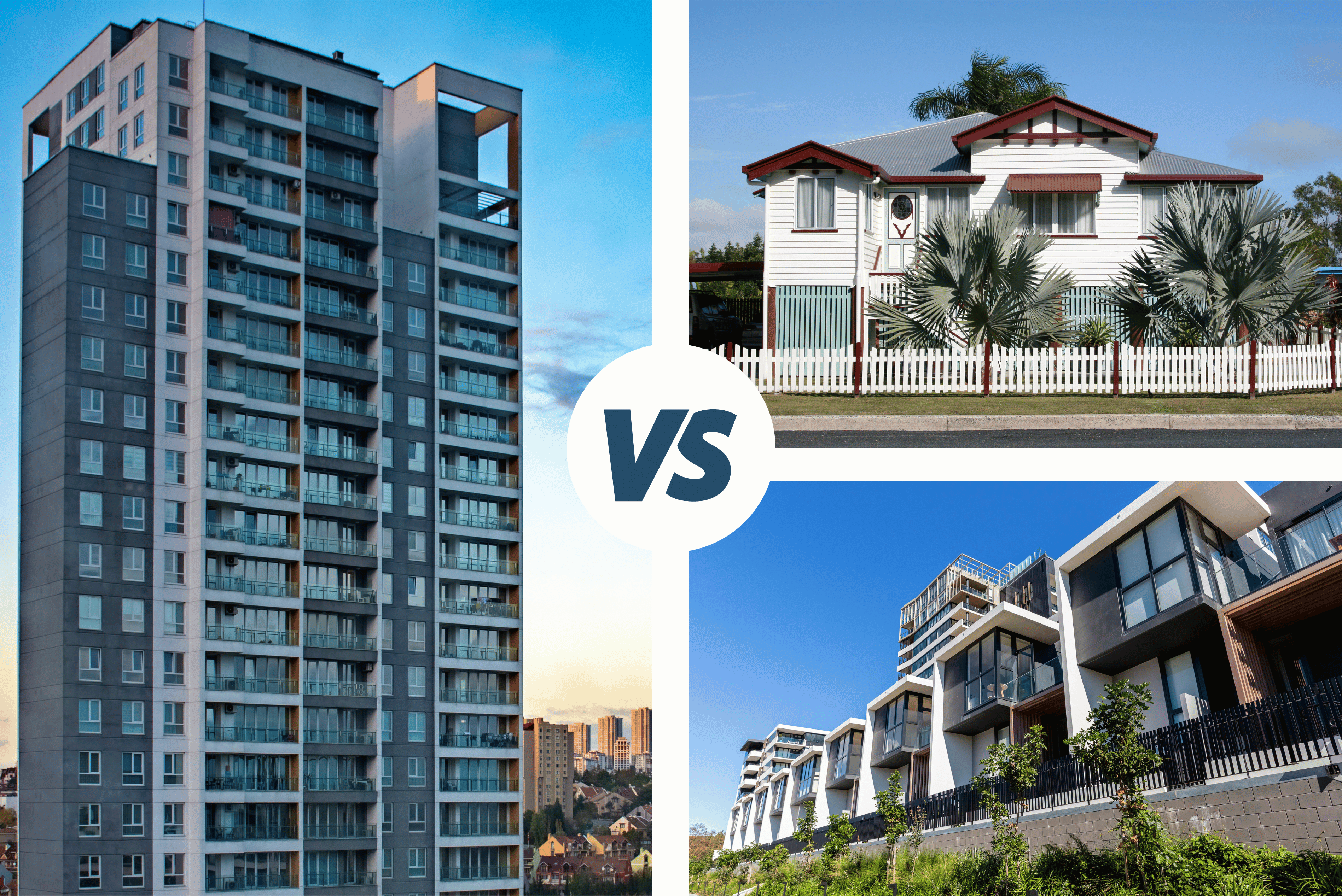Features > Property Education > Investment Tips
House, Townhouse, or Apartment: Which Property Type is the Best Investment for You?

KEY POINTS
- Houses, townhouses or apartments – is one investment better than another?
- Different dwelling types have different advantages, and you should take these into account
- Waiting for your ‘ideal’ investment could see you miss out on capital growth. Switching to a different dwelling type can get you into the game sooner
It’s one of the hottest topics in real estate investing.
What makes the best investments – houses, townhouses or apartments?
The good news is I have the answer.
And the answer is … it depends.
The type of property you should invest in comes down to one question.
Which one will help you hit your goals the fastest?
And everyone’s circumstances are different.
Sometimes you may need the benefits from a house, sometimes from a townhouse and sometimes from an apartment.
Chances are you’ll also switch from one to another as your journey to wealth progresses.
So rather than give you a definitive answer, I’ll explain the benefits and drawbacks of each style of housing, and where each one fits.

Capital growth potential
Without a doubt, houses have the highest capital growth potential.
Typically houses grow at a long-term average of 7% capital growth a year.
This means, that if growing equity is your biggest goal, then houses are your best option.
At 6%, capital growth for townhouses and apartments is still strong, although not as strong.
And while it might not seem to be a significant difference, the compounding effect of capital growth grows the gap as time goes on.
Using 7% and 6% average growth, you could expect a house to double in 10.3 years, and the townhouse or apartment to double in 12 years.
And since you’re using the equity you gain for your next investment, this becomes more and more significant over time.
Rental yields
Rental yields, like capital growth, are a crucial factor in determining the best investment for you.
The higher the yield, the more income there is going into your bank account.
And if they’re high enough, after you take your tax deductions into account, you could easily be cashflow positive.
Higher rental yields have two main benefits.
The first is obvious, and it’s more money in your pocket. And everyone likes that.
The other benefit is serviceability, which is how the bank determines your ability to repay your loan.
Depending on how much you earn, you may need a higher yield to be approved for a loan.
Typically, the smaller the land component of your investment, the higher the yield.
And you can see this in the numbers.
Across the board, in Australia, house and land rental yields are around 3.5%.
The rental yield on townhouses is 4%.
And the rental yield on apartments is 4.4%.
If your income doesn’t support a higher-growth house and land investment, switching to a townhouse or apartment could be what gets you into the market.
Maintenance and other ongoing expenses
Another factor that affects your income from your investment is maintenance and ongoing costs.
The higher these costs are, the less money there is left over for you.
The good news is these costs are fairly similar across all 3 investment types.
House and land investments usually experience the highest maintenance costs. However,
townhouses and apartments make up for it with body corporate fees of up to $4,000 a year.

Entry Cost
With the market in full swing, the longer you sit on the sidelines, the more capital growth you miss out on.
And of course, the main reason for this is the deposit.
The higher the price, the higher the deposit.
If you’ve got access to enough equity or cash for a house, then the entry cost isn’t an issue,
assuming, of course, you can service the loan.
However, there are always options.
The Australian median price for a free-standing house on land is $811,707.
The median price for a townhouse is a little lower at $750,000.
The median price for an apartment is $627,347.
Having said this, these are median prices, so there will always be good quality investments at lower price points, even if you have to drop into one-bedroom apartments to get your foot in the door.
Potential to add value
The final factor to consider is what you could do in the future.
And the simple rule here is, the more real estate you control, the more options you have.
A house on land might have a lower rental yield, however it comes with more options to add value to the dwelling.
You can add a pool to a house, or a larger patio or spa.
Maybe an extra bedroom or, possibly, build upstairs.
In an extreme case, you could subdivide or develop.
Adding value like this can increase the value of your property by more than you spend making the changes.
And of course, they allow you to increase the rents as well.
You can add some value with a townhouse if you have a backyard, but you probably won’t have as much.
And with an apartment or unit, your hands are tied.
What’s the answer?
The answer is … the best type of dwelling for you is the one which suits your circumstances, and gets you into the market and moving.
You should start by looking at all the options and seeing which fits your goals the best.
Stay Up to Date
with the Latest Australian Property News, Insights & Education.




.png?width=292&height=292&name=Copy%20Link%20(1).png)
 SIGN UP FOR FREE NEWSLETTER
SIGN UP FOR FREE NEWSLETTER





.jpg?width=1920&height=1080&name=Warning%2c%20You%20Might%20Be%20Facing%20Higher%20Taxes%20Soon%20(1).jpg)





.png?width=1920&height=1080&name=Rate%20Drops%20Signal%20BIGGEST%20Property%20Boom%20in%20DECADES%20(1).png)

.jpg?width=1920&height=1080&name=Labor%20vs%20Liberal%20These%20Housing%20Policies%20Could%20Change%20the%20Property%20Market%20Forever%20(1).jpg)
.jpg?width=1920&height=1080&name=QLD%20Slashes%20Stamp%20Duty%20Big%20News%20for%20Investors%20%26%20Home%20Buyers%20(1).jpg)
.jpg?width=1920&height=1080&name=Trump%20Just%20Slapped%20Tariffs%20%E2%80%93%20Here%E2%80%99s%20What%20It%20Means%20for%20Australia%20(1).jpg)
.jpg?width=1920&height=1080&name=Federal%20Budget%202025%20More%20Debt%2c%20No%20Housing%20%E2%80%93%20Here%E2%80%99s%20What%20You%20Need%20to%20Know%20(1).jpg)
.jpg?width=1920&height=1080&name=Australias%20Housing%20Crisis%20is%20about%20to%20get%20MUCH%20Worse%20(New%20Data%20Warns).jpg)
%20(1).jpg?width=1920&height=1080&name=Australias%20RENTAL%20CRISIS%20Hits%20ROCK%20BOTTOM!%20(2025%20Update)%20(1).jpg)
%20(1).png?width=1920&height=1080&name=Is%20Adelaide%20Still%20a%20Good%20Property%20Investment%20(2025%20UPDATE)%20(1).png)
.jpg?width=1920&height=1080&name=RBA%20Shocks%20with%20Rate%20Cuts!%20What%E2%80%99s%20Next%20for%20Property%20Investors%20(1).jpg)
%20(1).jpg?width=1920&height=1080&name=I%20Predict%20The%20Feb%20Rate%20Cut%20(My%20Price%20Growth%20Prediction)%20(1).jpg)
.png?width=1920&height=1080&name=Why%20Property%20Prices%20Will%20Rise%20in%202025%20Market%20Predictions%20(1).png)
.jpg?width=1920&height=1080&name=Why%20Investors%20Are%20Choosing%20Apartments%20Over%20Houses%202%20(1).jpg)
.jpg?width=1920&height=1080&name=Why%20Rate%20Cuts%20Will%20Trigger%20A%20Property%20Boom%20(1).jpg)
.jpg?width=1920&height=1080&name=Retire%20On%202Million%20With%20One%20Property%20(Using%20SMSF).jpg)
.jpg?width=1920&height=1080&name=4%20Reasons%20Why%20You%20Should%20Invest%20in%20Melbourne%20Now%20(1).jpg)
%20(1).jpg?width=1920&height=1080&name=Old%20Property%20vs%20New%20Property%20(Facts%20and%20Figures%20Revealed)%20(1).jpg)
%20(1).jpg?width=1920&height=1080&name=Will%20The%20New%20QLD%20Govt%20Create%20a%20Property%20Boom%20or%20Bust%20(My%20Prediction)%20(1).jpg)
%20Scott%20Kuru%20(1).jpg?width=1920&height=1080&name=Inflation%20Hits%20Three-Year%20Low%20(Will%20RBA%20Cut%20Rates%20Soon)%20Scott%20Kuru%20(1).jpg)
.jpg?width=1920&height=1080&name=How%20to%20Buy%20Investment%20Property%20Through%20SMSF_%20The%20Ultimate%20Guide%20(1).jpg)
.jpg?width=1920&height=1080&name=Victoria%20Slashes%20Stamp%20Duty%20Melbourne%20Set%20to%20Boom%20Scott%20Kuru%20(1).jpg)
.png?width=1571&height=861&name=Are%20Foreign%20Buyers%20Really%20Driving%20Up%20Australian%20Property%20Prices%20(1).png)
.jpg?width=1920&height=1080&name=The%20Single%20Factor%20That%20Predicts%20Property%20Growth%20Regions%20(1).jpg)
%20Scott%20Kuru%20(1).jpg?width=1920&height=1080&name=My%20Prediction%20On%20Rates%20%26%20Negative%20Gearing%20(Market%20Crash)%20Scott%20Kuru%20(1).jpg)

-1.png?width=1920&height=1080&name=Major%20Banks%20Cut%20Rates%20Will%20RBA%20Follow%20Suit%20(Sept%20Rate%20Update)-1.png)
%20Scott%20Kuru-1.png?width=1920&height=1080&name=Rate%20Cut%20Coming%20What%20New%20Zealands%20Move%20Means%20for%20Australia%20(Sept%20Prediction)%20Scott%20Kuru-1.png)
%20(1).jpg?width=1920&height=1080&name=Buy%20when%20the%20interest%20rates%20are%20high!%20(Why%20you%20must%20buy%20now!)%20(1).jpg)
.jpg?width=1920&height=1080&name=Carms_Revised%20Taxes%20Due%20Aug%209%20YT%20Thumbnail02%20(1).jpg)
.jpg?width=1920&height=1080&name=Carms_Too%20Little%20Too%20Late%20Aug%207%20YT%20Thumbnail01%20(1).jpg)









.jpg?width=1920&height=1080&name=Carms_Rate%20Drop%20In%20July%20Jun%2010%20YT%20Thumbnail02%20(1).jpg)
.jpg?width=1920&height=1080&name=Carms_Own%20a%20Property%20V6%20Jun%205_YT%20Thumbnail%20(1).jpg)









.png?width=1920&height=1080&name=Artboard%201%20(3).png)






.jpg?width=1920&height=1080&name=YT%20thumbnail%20%20(1).jpg)

